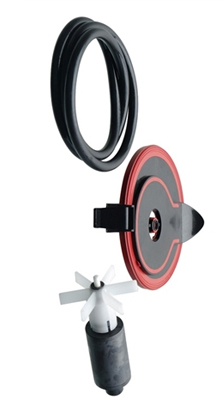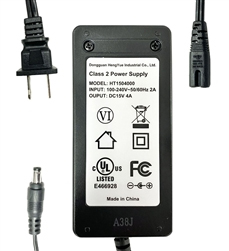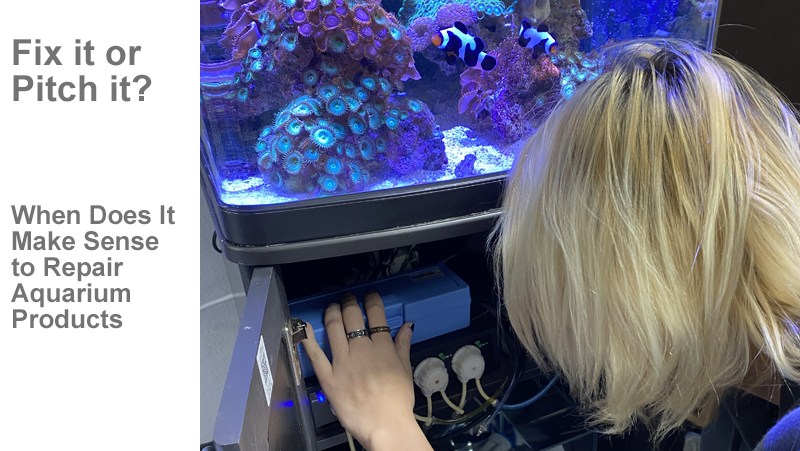Aquarium lights, filters, heaters, pumps, skimmers, aquariums, RO systems, and sterilizers are not cheap, and as with everything else the prices are going up. Weíve seen some manufacturers increase prices four times this year! In this time of economic uncertainty, the repair option starts to become more attractive than the replace option. Which aquarium gear can somewhat easily be repaired, and which aquarium gear is it only practical to replace?
Filters

Most aquarium filters only have one component with a moving part, the pump. The pump is where the majority of your problems occur. If you notice your filter slows down, stops, or has a grinding sound, open up the filter and inspect the pump impeller (
the part that spins). Check to see if the impeller well is swollen, the shaft is broken, the magnet is detached, or the blades of the impeller are damaged. The pump's motor and impeller are usually easy to replace and we offer a variety of impellers and motors in our
Aquarium Filtration Replacement Parts section. Everything is organized by brand and model.
Rubber filter pieces, such as gaskets and o-rings, get brittle and crack. With canisters filters, this can lead to leaks. We (
and many manufacturers) recommend replacing the gaskets and o-rings every year proactively. Or, at least every two to three years. A new o-ring is a lot cheaper than a new filter (
or cleaning up after a leak). Itís a good idea to have a main gasket on hand just in case.
We also sell quite a few hard plastic parts for canister filters in the
Aquarium Filtration Replacement Parts section.
Heaters
The vast majority of aquarium heaters have a moving bi-metal thermostat inside them that physically opens and closes to turn the heater on and off. The moving pieces inside the heater will eventually wear out and the heater can get stuck in the on or off position. There is no easy way to fix a heater at home as all of the relevant parts are sealed inside. Because heaters are not very expensive, and the consequence of a bad heater could be killing everything in your tank, it is good to replace heaters every five years. A heater line praised for having "unsurpassed reliability" is the
Fluval M-Series Submersible Heaters, and is a great choice for your budget.
Lights

Older style aquarium lights using fluorescent or metal halide lamps were somewhat easy to repair by replacing faulty ballasts, bulbs, wires, or fans. The modern LED aquarium lights are not very user-serviceable, but there are few user serviceable parts. If your LED light does not turn on, the first thing to check is the power supply. If your tank has multiple identical lights start by switching the power supplies between the lights. If the light does not turn on with any power supply connected then the light is bad. If the power supply does not turn on any of your lights, then the power supply is bad. If you donít have multiple lights, check to see if your power supply has a power indicator. If the power supply indicator light doesnít turn on, then it is likely bad. When replacing a power supply, make sure that the power supply matches the light model you have. Choosing the incorrect power supply can damage both the light and power supply. Check our
LED Light Replacement Parts section for power supplies.
LED fans are sometimes also replaceable. If your LED light stops working, first check to see if it is overheating. If the light has a fan, does it turn on? Does the light feel hot to the touch? These can indicate that the cooling system is failing on the LED light and this is triggering the light to turn off. Start by blowing out the light with compressed air and consider looking for a replacement cooling fan.
Pumps

Aquarium pumps can last a long time if cleaned and repaired periodically. The impeller is the moving portion of a utility pump and the rotor is the moving portion of a circulation pump. The blades of these impellers and rotors can break, and the shaft that they spin around can also break. If either of these parts looks swollen, broken, or warped, replacing them will often let you get years more out of the pump. If you have a DC controllable pump, the power supply and controller can also fail. Both the power supply and controller have power supply indicator lights they will let you know when they need to be replaced. Power supplies usually last three to five years. Controllers will last much longer (
unless you splash them with water). Check out our
Pump Replacement Parts section. About half of the section is rotors and impellers, but it also contains quite a few other parts such as volutes (
front covers), suction cups, and a wide variety of parts for gyre-style pumps.
RO Systems
Most RO systems have no electronics, so there is very little to fail. If your RO system starts to leak, it can most likely get fixed easily with the replacement canisters, O-rings, and fittings in our
RO Systems section (
parts at the bottom).
Aquariums
We do not recommend you fix an aquarium. Small aquariums are not very expensive to replace, and large aquariums have very dire consequences if your repair goes poorly. It is best to completely replace any leaking aquarium. If the leak is not from the aquarium itself, but instead a plumbing issue, then replacing plumbing or gaskets is easy and affordable. We have a wide variety of plumbing parts for
RedSea Aquariums and
standard bulkhead fittings that will fit many brands of aquariums.
Protein Skimmers
The only parts of a protein skimmer that usually wear out over time are pumps and gaskets. Most in sump skimmers will run without the rubber gaskets, but they may leak bubbles. If this annoys you, or if you have a hang on skimmer that leaks water, replacing gaskets will help. Replacing a pump or impeller can often make a skimmer like new again as the pump is the heart of the skimmer. Check out our
Protein Skimmer Replacement Parts section. Along with pumps and impellers, we also carry some collection cups (
usually needing replacement when dropped on the floor), pump controllers, controller power supplies and various other parts.
Always make sure to use the same brand and size of pump that your skimmer came with. Too large or too small of a pump will have the wrong balance of water to air for your skimmerís body, and it will not skim well. If your skimmer has a pump inside of the skimmer body, and the manufacturer has discontinued the pump, then you are out of luck finding a replacement, as the body was designed to fit a very specific pump.

If your skimmer has a pump on the outside of the body it may be possible to add a new pump to fix an older skimmer. We suggest contacting the manufacturer to determine if they have a recommended replacement pump. If they have no suggestion, then a controllable skimmer pump is the best replacement. The
Reef Octopus VarioS controllable Pumps will allow you to speed up and slow down the pump to match the correct pump output to your skimmerís body size more easily.
UV Sterilizers
UV sterilizers can last a very long time, but UV light degrades pretty much everything. The UV lamp should be replaced every year, and itís a good practice to replace and lubricate the O-rings and gaskets at the same time. Quartz sleeves break easily, often when replacing the bulb, and they are readily available and easy to replace.
We have most of the
replacement parts for the Lifegard Aquatics, Aqua Ultraviolet UV Sterilizers, as well as many parts for other popular brands (
UV lamps are in a separate section).
The UV fluorescent ballasts normally last 5-7 years before needing replacement. As most UVs only have one bulb it can be difficult to figure out whether the bulb is bad or the ballast is bad. Our advice is to keep old working bulbs (
they should be replaced before they fail) to use for testing to see if the bulb or ballast is bad. If your UV is not working, and your bulb is less than a year old (
and there are no leaks), you most likely need to replace the ballast.
Many aquarists do not realize UV light will degrade the body of a UV sterilizer over time. For most brands, once the body goes you will need to replace the unit. You will notice that the unit will get brittle, squishy, and even start letting light through, and then it will start leaking. The main body of a good UV sterilizer can last 10 years, but if you want even more life out of your UV consider the
Lifegard Aquatics Pro-MAX units with
replaceable inner sleeves. These units have plastic sleeves that are meant to be thrown away and replaced to protect the main body of the unit. If you regularly replace the inner sleeves you can make the unit last twice as long.





























 Most aquarium filters only have one component with a moving part, the pump. The pump is where the majority of your problems occur. If you notice your filter slows down, stops, or has a grinding sound, open up the filter and inspect the pump impeller (the part that spins). Check to see if the impeller well is swollen, the shaft is broken, the magnet is detached, or the blades of the impeller are damaged. The pump's motor and impeller are usually easy to replace and we offer a variety of impellers and motors in our
Most aquarium filters only have one component with a moving part, the pump. The pump is where the majority of your problems occur. If you notice your filter slows down, stops, or has a grinding sound, open up the filter and inspect the pump impeller (the part that spins). Check to see if the impeller well is swollen, the shaft is broken, the magnet is detached, or the blades of the impeller are damaged. The pump's motor and impeller are usually easy to replace and we offer a variety of impellers and motors in our  Older style aquarium lights using fluorescent or metal halide lamps were somewhat easy to repair by replacing faulty ballasts, bulbs, wires, or fans. The modern LED aquarium lights are not very user-serviceable, but there are few user serviceable parts. If your LED light does not turn on, the first thing to check is the power supply. If your tank has multiple identical lights start by switching the power supplies between the lights. If the light does not turn on with any power supply connected then the light is bad. If the power supply does not turn on any of your lights, then the power supply is bad. If you donít have multiple lights, check to see if your power supply has a power indicator. If the power supply indicator light doesnít turn on, then it is likely bad. When replacing a power supply, make sure that the power supply matches the light model you have. Choosing the incorrect power supply can damage both the light and power supply. Check our
Older style aquarium lights using fluorescent or metal halide lamps were somewhat easy to repair by replacing faulty ballasts, bulbs, wires, or fans. The modern LED aquarium lights are not very user-serviceable, but there are few user serviceable parts. If your LED light does not turn on, the first thing to check is the power supply. If your tank has multiple identical lights start by switching the power supplies between the lights. If the light does not turn on with any power supply connected then the light is bad. If the power supply does not turn on any of your lights, then the power supply is bad. If you donít have multiple lights, check to see if your power supply has a power indicator. If the power supply indicator light doesnít turn on, then it is likely bad. When replacing a power supply, make sure that the power supply matches the light model you have. Choosing the incorrect power supply can damage both the light and power supply. Check our  Aquarium pumps can last a long time if cleaned and repaired periodically. The impeller is the moving portion of a utility pump and the rotor is the moving portion of a circulation pump. The blades of these impellers and rotors can break, and the shaft that they spin around can also break. If either of these parts looks swollen, broken, or warped, replacing them will often let you get years more out of the pump. If you have a DC controllable pump, the power supply and controller can also fail. Both the power supply and controller have power supply indicator lights they will let you know when they need to be replaced. Power supplies usually last three to five years. Controllers will last much longer (unless you splash them with water). Check out our
Aquarium pumps can last a long time if cleaned and repaired periodically. The impeller is the moving portion of a utility pump and the rotor is the moving portion of a circulation pump. The blades of these impellers and rotors can break, and the shaft that they spin around can also break. If either of these parts looks swollen, broken, or warped, replacing them will often let you get years more out of the pump. If you have a DC controllable pump, the power supply and controller can also fail. Both the power supply and controller have power supply indicator lights they will let you know when they need to be replaced. Power supplies usually last three to five years. Controllers will last much longer (unless you splash them with water). Check out our  If your skimmer has a pump on the outside of the body it may be possible to add a new pump to fix an older skimmer. We suggest contacting the manufacturer to determine if they have a recommended replacement pump. If they have no suggestion, then a controllable skimmer pump is the best replacement. The
If your skimmer has a pump on the outside of the body it may be possible to add a new pump to fix an older skimmer. We suggest contacting the manufacturer to determine if they have a recommended replacement pump. If they have no suggestion, then a controllable skimmer pump is the best replacement. The